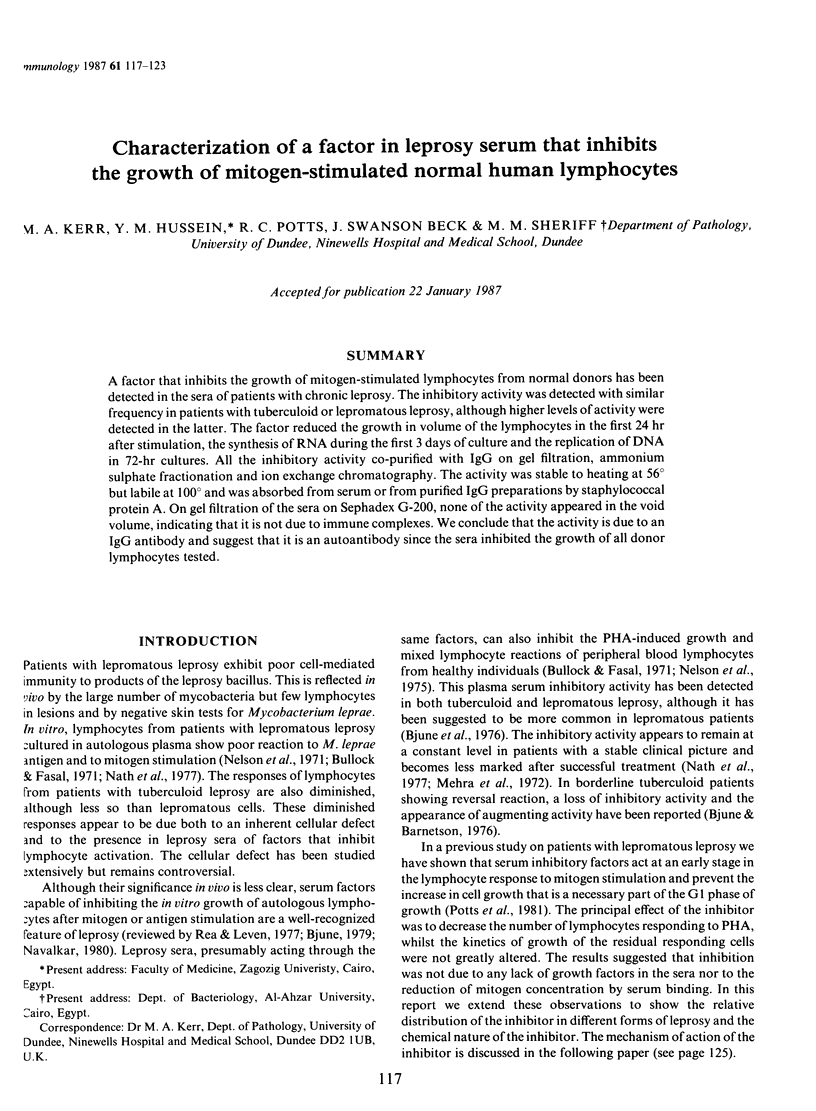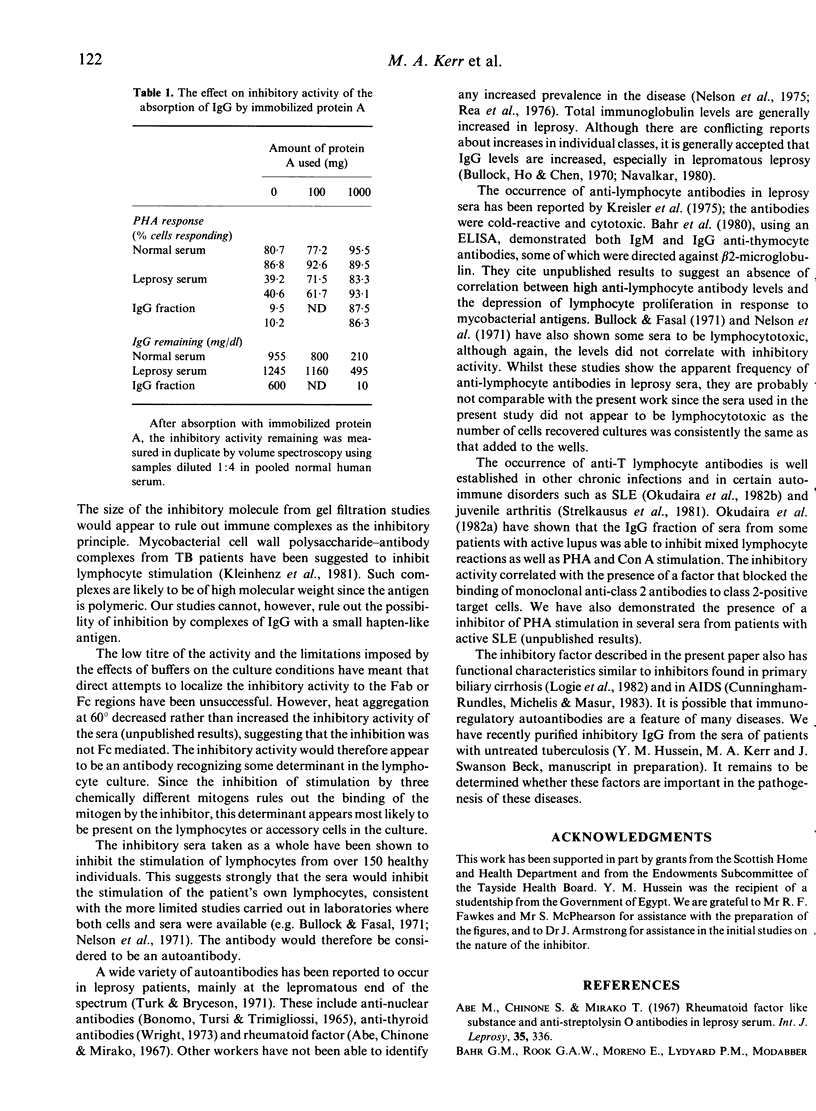Abstract
A factor that inhibits the growth of mitogen-stimulated lymphocytes from normal donors has been detected in the sera of patients with chronic leprosy. The inhibitory activity was detected with similar frequency in patients with tuberculoid or lepromatous leprosy, although higher levels of activity were detected in the latter. The factor reduced the growth in volume of the lymphocytes in the first 24 hr after stimulation, the synthesis of RNA during the first 3 days of culture and the replication of DNA in 72-hr cultures. All the inhibitory activity co-purified with IgG on gel filtration, ammonium sulphate fractionation and ion exchange chromatography. The activity was stable to heating at 56 degrees but labile at 100 degrees and was absorbed from serum or from purified IgG preparations by staphylococcal protein A. On gel filtration of the sera on Sephadex G-200, none of the activity appeared in the void volume, indicating that it is not due to immune complexes. We conclude that the activity is due to an IgG antibody and suggest that it is an autoantibody since the sera inhibited the growth of all donor lymphocytes tested.
Full text
PDF






Images in this article
Selected References
These references are in PubMed. This may not be the complete list of references from this article.
- Abe M., Chinone S., Hirako T. Rheumatoid-factor-like substance and antistreptolysin O antibody in leprosy serum. Significance in erythema nodosum leprosum. Int J Lepr Other Mycobact Dis. 1967 Jul-Sep;35(3):336–344. [PubMed] [Google Scholar]
- BONOMO L., TURSI A., TRIMIGLIOZZI G., DAMMACCO F. L.E. CELLS AND ANTINUCLEAR FACTORS IN LEPROSY. Br Med J. 1965 Sep 18;2(5463):689–690. doi: 10.1136/bmj.2.5463.689. [DOI] [PMC free article] [PubMed] [Google Scholar]
- Bahr G. M., Rook G. A., Moreno E., Lydyard P. M., Modabber F. Z., Stanford J. L. Use of the ELISA to screen for anti-thymocyte and anti-beta 2-microglobulin antibodies in leprosy and SLE. Immunology. 1980 Dec;41(4):865–873. [PMC free article] [PubMed] [Google Scholar]
- Bjune G., Barnetson R. S. Plasma factors in delayed-type hypersensitivity. Augmentation of lymphocyte responses in borderline leprosy reactions. Clin Exp Immunol. 1976 Dec;26(3):397–402. [PMC free article] [PubMed] [Google Scholar]
- Bjune G., Barnetson R. S., Ridley D. S., Kronvall G. Lymphocyte transformation test in leprosy; correlation of the response with inflammation of lesions. Clin Exp Immunol. 1976 Jul;25(1):85–94. [PMC free article] [PubMed] [Google Scholar]
- Bjune G., Duncan E., Barnetson R. S., Melsom R. In vitro modulation of lymphocyte responses to phytohaemagglutinin by plasma in mother and baby at the time of birth. Increased lymphocyte responses in babies of mothers with lepromatous leprosy. Clin Exp Immunol. 1978 Jun;32(3):517–522. [PMC free article] [PubMed] [Google Scholar]
- Bjune G. In vitro lymphocyte stimulation in leprosy; simultaneous stimulation with Mycobacterium leprae antigens and phytohaemagglutinin. Clin Exp Immunol. 1979 Jun;36(3):479–487. [PMC free article] [PubMed] [Google Scholar]
- Bradford M. M. A rapid and sensitive method for the quantitation of microgram quantities of protein utilizing the principle of protein-dye binding. Anal Biochem. 1976 May 7;72:248–254. doi: 10.1016/0003-2697(76)90527-3. [DOI] [PubMed] [Google Scholar]
- Bullock W. E., Jr, Fasal P. Studies of immune mechanisms in leprosy. 3. The role of cellular and humoral factors in impairment of the in vitro immune response. J Immunol. 1971 Apr;106(4):888–899. [PubMed] [Google Scholar]
- Bullock W. E., Jr, Ho M. F., Chen M. J. Studies of immune mechanisms in leprosy. II Quantitative relationships of IgG, IgA, and IgM immunoglobulins. J Lab Clin Med. 1970 May;75(5):863–870. [PubMed] [Google Scholar]
- Cunningham-Rundles S., Michelis M. A., Masur H. Serum suppression of lymphocyte activation in vitro in acquired immunodeficiency disease. J Clin Immunol. 1983 Apr;3(2):156–165. doi: 10.1007/BF00915487. [DOI] [PubMed] [Google Scholar]
- Gibbs J. H., Brown R. A., Robertson A. J., Potts R. C., Beck J. S. A new method of testing for mitogen-induced lymphocyte stimulation: measurement of the percentage of growing cells and of some aspects of their cell kinetics with an electronic particle counter. J Immunol Methods. 1979;25(2):147–158. doi: 10.1016/0022-1759(79)90050-4. [DOI] [PubMed] [Google Scholar]
- Kleinhenz M. E., Ellner J. J., Spagnuolo P. J., Daniel T. M. Suppression of lymphocyte responses by tuberculous plasma and mycobacterial arabinogalactan. Monocyte dependence and indomethacin reversibility. J Clin Invest. 1981 Jul;68(1):153–162. doi: 10.1172/JCI110231. [DOI] [PMC free article] [PubMed] [Google Scholar]
- Kreisler J. M., Arnaiz A., Perez B., Bootello A. Lumphocytotoxins in leprosy. Int J Lepr Other Mycobact Dis. 1975 Apr-Jun;43(2):91–94. [PubMed] [Google Scholar]
- Laemmli U. K. Cleavage of structural proteins during the assembly of the head of bacteriophage T4. Nature. 1970 Aug 15;227(5259):680–685. doi: 10.1038/227680a0. [DOI] [PubMed] [Google Scholar]
- Logie S. A., Quigley E. M., MacSween R. N., Sandilands G. P. Serum mediated inhibition of T-cell activation in primary biliary cirrhosis. J Clin Lab Immunol. 1982 Nov;9(2):81–85. [PubMed] [Google Scholar]
- Mehra V. L., Talwar G. P., Balakrishnan K., Bhutani L. K. Influence of chemotherapy and serum factors on the mitogenic response of peripheral leucocytes of leprosy patients to phytohaemagglutinin. Clin Exp Immunol. 1972 Oct;12(2):205–213. [PMC free article] [PubMed] [Google Scholar]
- Nath I., Curtis J., Sharma A. K., Talwar G. P. Circulating T-cell numbers and their mitogenic potential in leprosy--correlation with mycobacterial load. Clin Exp Immunol. 1977 Sep;29(3):393–400. [PMC free article] [PubMed] [Google Scholar]
- Navalkar R. G. Immunology of leprosy. Crit Rev Microbiol. 1980;8(1):25–47. doi: 10.3109/10408418009085077. [DOI] [PubMed] [Google Scholar]
- Nelson D. S., Nelson M., Thurston J. M., Waters M. F., Pearson J. M. Phytohaemagglutinin-induced lymphocyte transformation in leprosy. Clin Exp Immunol. 1971 Jul;9(1):33–43. [PMC free article] [PubMed] [Google Scholar]
- Nelson D. S., Penrose J. M., Waters M. F., Pearson J. M., Nelson M. Depressive effect of serum from patients with leprosy on mixed lymphocyte reactions. Influence of anti-leprosy treatment. Clin Exp Immunol. 1975 Dec;22(3):385–392. [PMC free article] [PubMed] [Google Scholar]
- Okudaira K., Searles R. P., Goodwin J. S., Williams R. C., Jr Antibodies in the sera of patients with systemic lupus erythematosus that block the binding of monoclonal anti-Ia to Ia-positive targets also inhibit the autologous mixed lymphocyte response. J Immunol. 1982 Aug;129(2):582–586. [PubMed] [Google Scholar]
- Okudaira K., Searles R. P., Tanimoto K., Horiuchi Y., Williams R. C., Jr T lymphocyte interaction with immunoglobulin G antibody in systemic lupus erythematosus. J Clin Invest. 1982 Apr;69(4):1026–1038. doi: 10.1172/JCI110506. [DOI] [PMC free article] [PubMed] [Google Scholar]
- Potts R. C., Sherif M. M., Robertson A. J., Gibbs J. H., Brown R. A., Beck J. S. Serum inhibitory factor in lepromatous leprosy: its effect on the pre-S-phase cell-cycle kinetics of mitogen-stimulated normal human lymphocytes. Scand J Immunol. 1981 Sep;14(3):269–280. doi: 10.1111/j.1365-3083.1981.tb00564.x. [DOI] [PubMed] [Google Scholar]
- Rea T. H., Levan N. E. Current concepts in the immunology of leprosy. Arch Dermatol. 1977 Mar;113(3):345–352. [PubMed] [Google Scholar]
- Rea T. H., Quismorio F. P., Harding B., Nies K. M., Di Saia P. J., Levan N. E., Friou G. J. Immunologic responses in patients with lepromatous leprosy. Arch Dermatol. 1976 Jun;112(6):791–800. [PubMed] [Google Scholar]
- Ridley D. S., Jopling W. H. Classification of leprosy according to immunity. A five-group system. Int J Lepr Other Mycobact Dis. 1966 Jul-Sep;34(3):255–273. [PubMed] [Google Scholar]
- Turk J. L., Bryceson A. D. Immunological phenomena in leprosy and related diseases. Adv Immunol. 1971;13:209–266. doi: 10.1016/s0065-2776(08)60185-6. [DOI] [PubMed] [Google Scholar]



